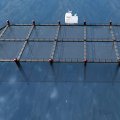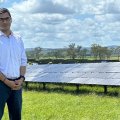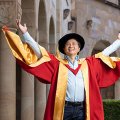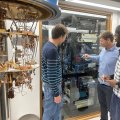
A group of leading Australian scientists has come together to develop lower-cost flexible optoelectronic solutions that could transform the Australian consumer electronics industry.
The Transparent Electrodes for Plastic Electronics Research Cluster, launched today, brings together a team of experts from CSIRO and three Australian universities – The University of Queensland, the University of Technology Sydney and Flinders University.
With over $3 million in funding contributed to the research cluster by CSIRO Flagship Collaboration Fund and a further $3 million from the partnering universities, the project will run until June 2014.
One of the cluster’s key goals is to produce cheap, flexible optoelectronic devices such as displays and lighting based on organic light-emitting diodes (OLEDs), solar cells, plastic electronics and sensors – technologies for use in products ranging from plastic solar cells to flexible televisions.
Dr Calum Drummond, Group Executive of CSIRO’s Manufacturing, Materials and Minerals Group, said the research cluster provided a new and very unique combination of skills and technical capability in Australia.
“The cluster consists of leading Australian scientists with individual specialist skills in areas such as nanoscience, thin film deposition and characterisation, chemical physics and electrical engineering,” he said.
“This is a novel partnership and one which is essential to the development of new commercial products such as plastic solar cells, solid-state lighting, flexible TV screens, computer displays and beyond,” said Mr Drummond.
Cluster Leader Professor Paul Burn, Director of the Centre for Organic Photonics and Electronics at UQ, says organic (plastic) optoelectronics is a fast-growing area that had the potential to lead to a “multitude of commercialisation pathways”.
“Australia should play a leading role in plastic optoelectronics to give us the best chance for being a net exporter of technologies, rather than an importer.”
A major challenge will be to find a robust, processable, cost-effective electrode manufacturing material to replace indium tin dioxide, an expensive, inflexible and fragile material that has been widely used previously, but is projected to be in short supply in 20 years.
Professor Burn said such collaboration offered a platform for sharing innovations and perspectives, while working towards a single focus.
“Collaborations across disciplines can spark new ideas, different approaches to solving a problem and provide the necessary expertise to join the scientific dots,” he said.
“Such an approach can give rise to faster outcomes and potentially new intellectual property.”
UQ Vice-Chancellor, Professor Debbie Terry, said the cluster would attract young Australian and international researchers, who might contribute to the rise of a new Australian manufacturing industry.
“Their work may lead to products that are cost-effective for export, and in-demand from a global market including remote area health workers and CBD technophiles,” Professor Terry said.
The cluster was created under the CSIRO Future Manufacturing National Research Flagship, which aims to lead the development of cleaner advanced materials and manufacturing technologies, in building Australia’s future productivity and prosperity.
The flagship is a substantial flexible electronics program and is one of the premier research teams in this field in Australia.
THE CLUSTER INCLUDES:
• The Centre for Organic Photonics & Electronics, The University of Queensland
• Institute for Nanoscale Technology, The University of Technology, Sydney
• Flinders Centre for NanoScale Science & Technology, Flinders University
• CSIRO Future Manufacturing Flagship Flexible Electronics.
THE TEAM INCLUDES:
• UQ: Prof Paul Burn (Cluster Leader), Prof Paul Meredith (Cluster Project Leader), Associate Professor Lianzhou Wang and Dr Muhsen Aljada.
• Flinders University: Prof David Lewis (Cluster Project Leader), Dr Gunther Andersson, and Professor Joe Shapter.
• The University of Technology, Sydney: Professor Geoff Smith (Cluster Project Leader).
BACKGROUND
Organic (plastic) optoelectronics is a fast growing technology area as manufacturers seek to produce cheap, flexible optoelectronic devices such as displays and lighting based on organic light-emitting diodes (OLEDs), solar cells, plastic electronics, and sensors.
OLED and solar cell technologies are already coming to market, for example the Samsung Galaxy S2 has an OLED screen and Konarka in the US is selling “power plastic”, which is based on plastic solar cell technology.
The transparent electrode of choice for many years has been indium tin oxide (ITO), which has acceptable light transmission and conductivity. ITO is currently used in touch screen displays (such as smart phones) and LCD displays, and is being used at an ever-increasing rate. At projected usage rates without recycling, it is estimated within the next 20 years the most easily accessed indium supplies will be exhausted.
ITO is also brittle, so the cluster will seek transparent conducting materials that are flexible and can be used with organic optoelectronic materials in simple, reel-to-reel manufacturing processes on flexible substrates.
Images available at: http://omc.uq.edu.au/images/cluster/
Media: Professor Paul Burn (07 334 67614 or p.burn2@uq.edu.au)
Background information available
http://www.csiro.au/Organisation-Structure/Flagships/Future-Manufacturing-Flagship/Future-Manufacturing-Flagship-Overview.aspx
Media Assistance: Janelle Kirkland, UQ Communications (07 3346 0561 or j.kirkland@uq.edu.au)













